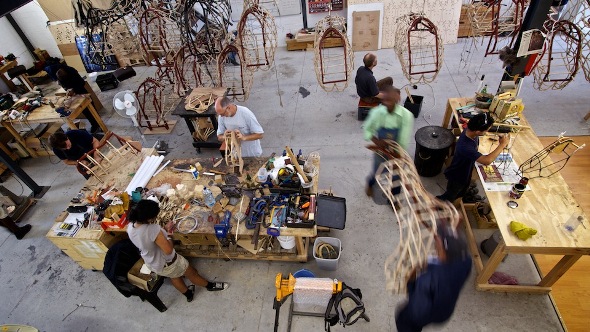Joey’s got them under his skin: The secret life of those magical puppeteers in ‘War Horse’
 Feature: It takes three actor-puppeteers in sync to breathe life into the title character of “War Horse,” the popular play by the National Theatre of Great Britain in collaboration with Handspring Puppet Company. Currently touring the U.S., “War Horse” plays the Cadillac Palace Theatre through Jan. 5.
Feature: It takes three actor-puppeteers in sync to breathe life into the title character of “War Horse,” the popular play by the National Theatre of Great Britain in collaboration with Handspring Puppet Company. Currently touring the U.S., “War Horse” plays the Cadillac Palace Theatre through Jan. 5.
By Nancy Malitz
When you first catch sight of the magnificent adult horse called Joey, the title character in “War Horse,” you look for the extra legs.
You know Joey’s a puppet. You strain to glimpse the evidence. But within minutes the chestnut half-thoroughbred comes alive for you, chest expanding, ears alert, pawing the ground and nuzzling the boy who loves him.
 “War Horse” is a theatrical saga about Albert, an English farm boy, and Joey, his beloved horse, who is sold to the cavalry and shipped to the French killing fields of World War I. But Albert is fiercely determined to rescue Joey, and thereby hangs a tale.
“War Horse” is a theatrical saga about Albert, an English farm boy, and Joey, his beloved horse, who is sold to the cavalry and shipped to the French killing fields of World War I. But Albert is fiercely determined to rescue Joey, and thereby hangs a tale.
Hints of human manipulation are barely visible under Joey’s translucent skin, which is attached to the graceful ribs, made of cane, that define chest, neck and haunches. (Can you see the puppeteer’s head, behind the rider’s leg in Joey’s flank, at left?) But as Joey whinnies, lifts his forearm and bends his knee, causing the hoof to drop into that characteristic equine dangle, you find yourself conspiring to believe he’s real.
 That’s fine with Patrick Osteen, Jessica Krueger and Jon Riddleberger, the three performers who enact a nightly choreography of collaborative maneuvers that bring Joey to life. It’s when puppeteers disappear in the mind of the viewer that they know they’ve hit their groove, as Joey’s co-creator, South-African master puppet designer Adrian Kohler, is fond of saying.
That’s fine with Patrick Osteen, Jessica Krueger and Jon Riddleberger, the three performers who enact a nightly choreography of collaborative maneuvers that bring Joey to life. It’s when puppeteers disappear in the mind of the viewer that they know they’ve hit their groove, as Joey’s co-creator, South-African master puppet designer Adrian Kohler, is fond of saying.
The Joey trio has been together since early spring 2012, when they underwent total immersion training at the behest of Handspring Puppet Company. Without the magnificent creatures created by company founders Kohler and Basil Jones, longtime puppeteers in their own right, “War Horse” the play would not be possible.
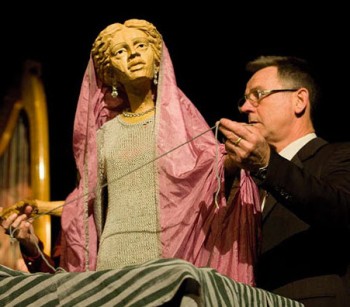 Based in Cape Town, Jones and Kohler have worked for decades breathing life into forms as varied as chimpanzees, hyennas and giraffes, not to forget iconic characters of myth and legend such as Faust, Penelope, Ulysses and Woyzeck.
Based in Cape Town, Jones and Kohler have worked for decades breathing life into forms as varied as chimpanzees, hyennas and giraffes, not to forget iconic characters of myth and legend such as Faust, Penelope, Ulysses and Woyzeck.
The national tour of “War Horse” opened in Boise ID in June 2012, and Krueger, Osteen and Riddleberger have since played Los Angeles, San Francisco, Atlanta, Durham, Boston, Washington D.C. and points between.
If that makes Broadway in Chicago audiences late to the game, so much the better. Jones, who is Handspring’s executive producer, once confessed that the ideal time to see a performance of “War Horse” is well into its run — at least a hundred performances in — because of the sophistication that develops only gradually, over time, among the puppet collaborators. “I never realized how transformative their performances would become,” Jones admitted. “They have taken these beautiful puppets to another realm. The realization that the performers don’t need to talk to each other becomes stronger and stronger for them.”
Riddleberger, who controls Joey’s head, says the Handspring teachers during two weeks of intensive training challenged the puppeteers to continue working on “being” a horse: “We were even encouraged to surprise the actors from time to time.” His Twitter feed from April 9 documents some recommended reading from that period.
Jones and Kohler say they like to go for a mixture of skills when they put together a team of puppeteers for Joey and for the full thoroughbred Topthorn, Joey’s even bigger pal. Acrobatics, dance, physical and straight theater talents all are sought, along with specific heights and the ability to handle a heavy load.
 Riddleberger learned his very physical approach to acting at New York University’s Tisch School of the Arts Experimental Theatre Wing. As the only puppeteer who’s visible always, he relies heavily on a first principle he learned from Handspring, called the “devotional state,” to cope with the exposure: “It means I put the puppet ahead of myself always. It is a challenge physically, because I have to be consciously very hard on myself to make sure I do not make a single move unless it is related to Joey and what the horse is doing. If I am going to take a step, Joey has to be part of that step.”
Riddleberger learned his very physical approach to acting at New York University’s Tisch School of the Arts Experimental Theatre Wing. As the only puppeteer who’s visible always, he relies heavily on a first principle he learned from Handspring, called the “devotional state,” to cope with the exposure: “It means I put the puppet ahead of myself always. It is a challenge physically, because I have to be consciously very hard on myself to make sure I do not make a single move unless it is related to Joey and what the horse is doing. If I am going to take a step, Joey has to be part of that step.”
Patrick Osteen, who operates Joey’s front legs, spent some time around horses when he was young. His theatrical training had a classical component — he has choreographed fight scenes and played the gang leader Mercutio in Shakespeare’s “Romeo and Juliet.”
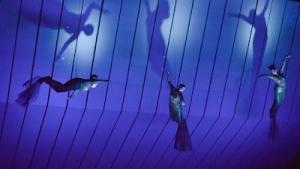 Krueger, who controls Joey’s back legs from inside the animal, has a strong acrobatic history. She recently puppeted the tail of the dragon Fafner in the Metropolitan Opera production of Wagner’s “Ring” Cycle. She also worked as a double, to help create the impression that Wagner’s Rhine Maidens could swim and that Valkyries could fly.
Krueger, who controls Joey’s back legs from inside the animal, has a strong acrobatic history. She recently puppeted the tail of the dragon Fafner in the Metropolitan Opera production of Wagner’s “Ring” Cycle. She also worked as a double, to help create the impression that Wagner’s Rhine Maidens could swim and that Valkyries could fly.
Inside Joey, Krueger takes her cues from Patrick Osteen, who is in front of her and cannot see her at all. “The first day that we galloped together in training,” Krueger says, “we worked on it for about ten minutes and I was already exhausted. It’s my job to keep the gait in proper form, so I’m sort of swimming behind Patrick, moving with his footsteps. At first we were trying so hard we used a lot more muscular energy than we needed to, but eventually we became more efficient and relaxed, and it has definitely gotten easier.”
“War Horse” started life as a book, published in 1982 by Michael Morpurgo and intended for young readers. It was inspired by the tales he heard in Devonshire about the horses who died by the hundreds of thousands in World War I battlefields, and the people who cherished them. The book languished happily in bins and libraries until the mother of Tom Morris, a director then at the National Theatre in London, said he really ought to turn it into a play.
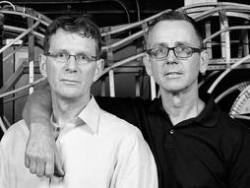 Nick Stafford set about adapting the novel and that’s when the theater got in touch with Handspring gurus Jones and Kohler, who spent several years developing the horse prototypes.
Nick Stafford set about adapting the novel and that’s when the theater got in touch with Handspring gurus Jones and Kohler, who spent several years developing the horse prototypes.
How did they do it? Best to let them tell you. The two puppet masterminds are thoroughly entertaining in this 15-minute demonstration, directly below, which they gave at the 2011 TED conference devoted to “ideas worth spreading.” Their talk details the breakthrough thinking required to create Joey and Topthorn. They had to advance their puppet technology from a smallish, hand-held hyenna, operated by two people, intended for viewing only from the front, to a 360-degree full-size horse, operated by three people and capable of supporting a human rider. They would also need to simulate a gallop and other gaits, as well as allow for kicking and fighting with another full-size puppet horse in full stride.
Steven Spielberg, by his own account moved to tears at the London play, would next make a movie of the story. It opened on Dec. 25, 2011, without puppets, of course, but solving in a cinematic way the need to make Joey a fully expressive character. Movie and stage play have enjoyed a certain synergy ever since, the one successful effort creating a ready made audience for the other.
Joey’s prolonged popularity and his rugged performance schedules came as something of a surprise to Jones and Kohler, who never imagined that they would need to build their cloth and reed creations to withstand years of wear and tear and thousands of performances. The routine takes a toll on performers, too.
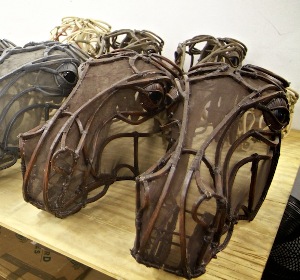 “It’s the repetitions mostly,” says Osteen, who’s generally under Joey’s shoulders. “The positions we maintain, and the very specific movements they require — such as the wrist movements in my case, and the legs in constant pliés,” he explains, referring to the balletic knee bends. The puppeteers take their physical therapy seriously and are constantly monitoring for safer ways of doing things.
“It’s the repetitions mostly,” says Osteen, who’s generally under Joey’s shoulders. “The positions we maintain, and the very specific movements they require — such as the wrist movements in my case, and the legs in constant pliés,” he explains, referring to the balletic knee bends. The puppeteers take their physical therapy seriously and are constantly monitoring for safer ways of doing things.
Since bionic therapy’s not readily available for Joey, Handspring has adjusted accordingly: Nowadays, when they ship out a new Joey, the package includes two necks, a couple of heads and eight legs, just in case.
Here’s the “War Horse” schedule into 2013:
- U.S. national tour: After Chicago — tickets here— “War Horse” moves on as follows:
- Denver and Costa Mesa in January 2013
- Tempe, then Seattle and Portland in February
- Spokane, then St. Louis and Cincinnati in March
- Cleveland in April
- Tampa, then Fort Lauderdale as well as Fayetteville AR and Charlotte NC in May
- Providence RI, then Minneapolis and Appleton WI in June.
- London: Meanwhile, a sit-down production at New London Theatre in Drury Lane (home of the original “Cats” in 1981) continues.
- International: The UK and Ireland tour starts up in September 2013, and the first non-English language production, in Berlin, will begin in October 2013.
- Performance locations, dates and times: Details at TheatreinChicago.com
- Michael Marpurgo was inspired to write “War Horse” while in Devonshire: Learn why at guardian.co.uk
Photo captions and credits: Home page and top: Joey, the title character of “War Horse,” is brought to life by three puppeteers, including two inside the animal. Descending: Barely visible inside Joey’s flank, behind the rider’s calf, is puppeteer Jessica Krueger. Patrick Osteen, Jessica Krueger and Jon Riddleberger are the nearly invisible puppeteers who work together to create Joey. (“War Horse” photos by Brinkhoff-Mögenburg.) Basil Jones, co-founder and executive producer of Handspring Puppet Company, works with Penelope, a puppet from earlier days. (Photo by Handspring.) Puppeteer Jon Riddleberger avoids eye contact and makes no move onstage unless it involves Joey. (Photo by Brinkhoff-Mögenburg.) Jessica Krueger’s acrobatic background involved previous work helping the Metropolitan Opera’s Rhine Maidens appear to swim. (Photo by Ken Howard.) Basil Jones and Adrian Kohler, founders of Handspring Puppet Company and the creators of Joey. (Photo by Handspring.) Jones and Kohler speak at the TED 2011 conference about the challenge of designing Joey. (TED.com) Extra heads line up at the Handspring workshop. Below: Grayson DeJesus on Topthorn and Michael Wyatt Cox on Joey in the battlefields of France. (Photo by Brinkhoff-Mögenburg.) Handspring Puppet Company workshop, overhead view. (www.handspringpuppet.co.za.)
Tags: Adrian Kohler, Basil Jones, Cadillac Palace Theatre, Devonshire, Experimental Theatre wing, Handspring Puppet Company, Jessica Krueger, Jon Riddleberger, Metropolitan Opera, Michael Morpurgo, National Theatre of Great Britain, New School, Patrick Osteen, puppet technology, Ring Cycle, Steven Spielberg, Tisch School of the Arts, War Horse


